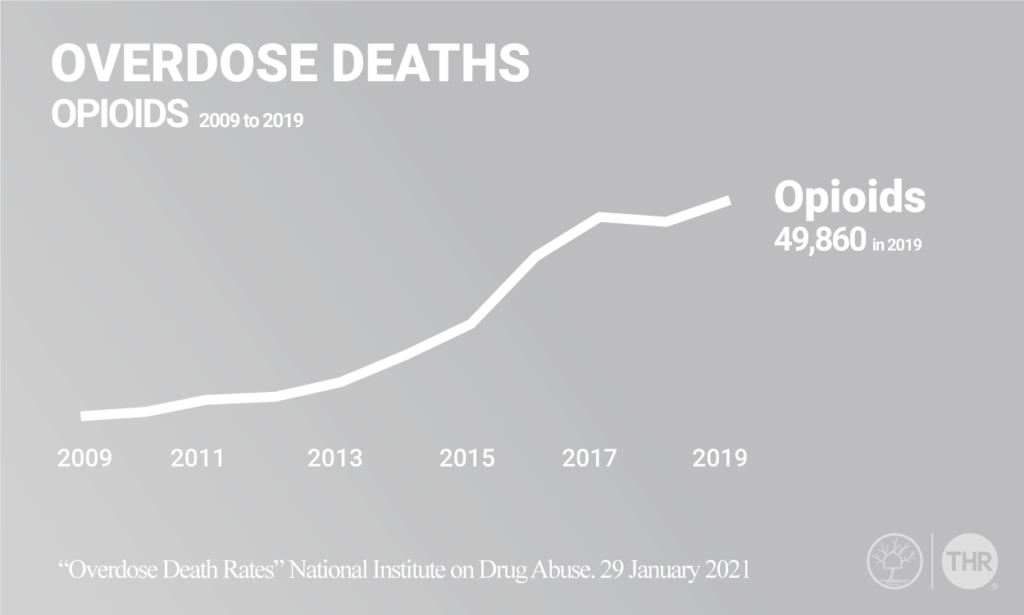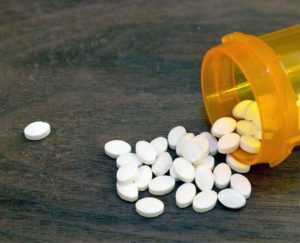Understanding and Overcoming Opioid Addiction
What are Opioids?
Opioids are synthetic drugs developed to relieve pain. Opioids work by dulling the brain’s ability to receive pain signals from the body, which creates the perception that there is no pain [1]. Doctors may prescribe opioids like Vicodin, Percocet, and OxyContin to patients after surgery or to help manage chronic pain conditions. But because opioids create euphoria and numb pain, they can be highly addictive and be a gateway drug for other addictions. 75% of people recovering from heroin addiction reported that they started with opioid pain pills [2]. At Tree House Recovery, we offer effective, evidence-based treatment for opioid addiction in North Carolina. Learn more about our substance abuse programs by connecting with our team today at 910-812-1728.
Most opioids are Schedule II narcotics [3], meaning they are available with a prescription for specific medical purposes but have a high potential for abuse.
Narcotic Analgesic
The Origins of Opioids
Opioids all originate from the opium poppy plant, which grows natively in South America, Mexico, the Middle East, and Asia [4]. The opium poppy has a long history of use. Civilizations as far back as Ancient Sumeria in 3,000 BC were aware of its anesthetic and euphoric effects [5]. Eventually, chemists distilled opium poppy sap to make opium, refined opium into morphine in the early 1800s, and synthesized morphine into heroin in 1874—all of which became illegal in the U.S. after 1920 [5]. Oxycodone, the first prescription opioid, became available in 1916 [6]. For nearly 80 years, opioids were only prescribed for patients with cancer or to help manage near-death pains. Then, in 1995, Purdue Pharmaceutical began aggressively marketing opioids to doctors [7]. They claimed their opioids were non-habit-forming and, therefore, should be available for widespread use [7]. Purdue illegally paid doctors to write more prescriptions which effectively kicked off the first opioid epidemic [8]. Today, opioids kill more Americans than any other drug [9].
What Do Opioids Look Like?
There are many different kinds of opioids that have different shapes, appearances, and consistencies. For instance, methadone usually looks like green jello-like goo. Fentanyl can be a spray or a powder. Heroin can be a powder, tar, or liquid. Codeine is found in cough syrup. But most prescription opioids come in pill form. Because these prescription opioids are mass-produced, each pill has unique markings that you can use to identify them.
So, if you believe you have found an opioid, you can identify it with an online pill identifier.
How are Opioids Used?
People who abuse prescription opioids take the pill orally, but these pills can also be crushed and inhaled through the nose to produce the effects more quickly. Opioids that aren’t pills can also be injected or smoked. People who abuse opioids may also mix them with other drugs like alcohol, benzos, or cocaine. With cocaine, opioids counter the effects, making it possible to use higher amounts of both drugs. However, this increases the risk of overdose when one drug wears off. When mixed with other depressants like alcohol or benzos, a person’s breathing rate can slow down to life-threatening levels.
The Dangers of Opioids
Opioids are depressants that work by dulling your brain’s perception of pain and also slowing down the activity in your central nervous system. When taken in excess, your brain can slow down enough that it loses the ability to control the heart and lungs, which leads to overdose symptoms. As of 2021, opioid overdoses have killed more people than any other drug [9]. While this is mostly due to the rise in fentanyl use, 75% of fentanyl and heroin users report that their first opioid was a prescription pill [2]. Any use of opioids outside of their prescribed medical use is considered abuse and can indicate a need for an opioid addiction treatment center.
Opioid Overdose Rates:
In 2019, overdose deaths increased 4% compared to 2018—there were 70,630 drug overdose deaths in the U.S. As a result, opioids were involved in 71% of 2019’s overdose death count in 2019. That’s 49,860 deaths.
For more information on Fentanyl and Heroin
Opioids Overdose Graph:

Signs of Opioid Abuse
Physical Signs:
Opioids work by limiting the brain and body’s ability to communicate with one another. The most common effect of this is that pain signals no longer reach the brain. But frequent doses also impair other things the brain regulates such as the heart, lungs, digestive system, and blood flow throughout the body [11]. The results of this slowed-down state are what produce the signs of opioid abuse, which include [12].
- Lack of appetite
- Weight loss
- Constipation
- Small “pinned” pupils
- Lower body temperature
- Low sex drive
Changes in Behavior
Opioids produce a euphoric effect, making it easy for a person to keep using them. Dependence can build in a matter of weeks because of this. As a result, when they stop opioids, they will experience withdrawal symptoms as well as the behaviors associated with trying to end those uncomfortable withdrawal symptoms [12]:
- Sleeping a lot or for long periods
- Poor physical hygiene
- Loss of interest in former hobbies
- Isolating from friends
- New financial difficulties
- Loss of interest in exercise
- Stealing from friends and family
- Lying
- Doctor Shopping for pills
- Twitching
- Itching
- Restlessness
- Vomiting/nausea
- Insomnia
Side Effects of Opioids:
Opioid receptors exist throughout the brain and body. Opioids bind to them and slow everything down. They also stimulate the brain’s reward system to produce the pleasure transmitter dopamine [12]. As a result, while on opioids, people experience a euphoric sense of painlessness and safety. But when the effects end, particularly for people who have formed a physical dependence, they will experience the opposite of these effects [12]. The most common side effects of opioids include:
- Feelings of euphoria
- Feelings of warmth or safety
- Drowsiness
- Dizziness
- Euphoria
- Nausea
- Pain relief
- Sedation
- Tolerance
- Relaxation
- Respiratory depression and arrest
- Unconsciousness
- Coma
- Sedation
- Tolerance
- Relaxation
- Respiratory depression and arrest
- Unconsciousness
- Urinary retention
Common Names for Opioids
There are many different kinds of opioids, and people who abuse them may use “street names” to discuss them in public places. If you hear someone using one of these terms, it could be a sign that they are using opioids and would benefit from an opioid addiction treatment program: [12]
Opioid Street Names
Buprenorphine (Suboxone, Subutex)
Big Whites, Buse, Oranges, Small Whites, Sobos, Stops, Strips, Sub, Subs
Codeine
Captain Cody, Cody, Little C, Schoolboy, Lean, Purple Drank, Sizzurp, Texas Tea
Fentanyl (Actiq, Sublimaze)
Apache, China Girl, China White, Dance Fever, Friend, Goodfella, Jackpot, Murder 8, Tango and Cash, TNT
Hydrocodone (Lortab, Norco, Vicodin)
Bananas, Dro, Fluff, Hydros, Tabs, Vikes, V-itamin, Watson-387, 357s
Hydromorphone (Dilaudid, Exalgo)
D, Dillies, Footballs, Juice, Smack
Meperidine (Demerol)
Demmies, Pain Killer
Methadone (Dolophine, Methadose, Amidone)
Dollies, Dolls, Fizzies, Mud, Red Rock, Tootsie Roll
Morphine (Duramorph)
MS Contin, God’s Drug, M, Miss Emma, Monkey, Morpho, White Stuff
Oxycodone (OxyContin, Percocet)
30s, As, Berries, Blues, Blueberries, Hillbilly Heroin, Ms, O.C., Oxy, Oxycet, Oxycotton, Ozone, Roxy, Ercs, Greenies, Kickers, M-30s, Percs, Rims, Tires, Wheels, 512s
Oxymorphone (Opana)
Biscuits, Blue Heaven, Mrs. O, O Bomb, Octagons, Stop Signs
Propoxyphene (Darvocet®, Darvon®)
Footballs, N’s, Pink Footballs, Pinks, Yellow Footballs, 65s
Tramadol (Ultram®)
Chill Pills, Trammies, Ultras
Opioid Withdrawal Symptoms
Opioid withdrawal usually begins three to 48 hours after the effects of the drug wear off. Withdrawal symptoms and severity will vary depending on how long you’ve used opioids and at what dose, but typically day three is the peak of the symptoms [13]. Common withdrawal symptoms include:
- Nausea and vomiting
- Pain
- Diarrhea
- Insomnia
- Anxiety
- Fever
- Racing heart
- Sweating
- Chills
Our Opioid Addiction Treatment Program in North Carolina
Recovering from opioid addiction takes three things: a detox to help your body function properly again without narcotics, a rehab to treat the social, physical, and mental causes and effects of your addiction, and an aftercare plan that will help you stay sober.
 Opioid Medical Detox
Opioid Medical Detox
There is a reason that detoxing from opioids has a reputation for being difficult. It’s painful. That is why it’s always best to do it at a medical detox center. Doctors can provide special medications that will reduce the number and severity of your withdrawal symptoms. While detoxing at home from opioids isn’t necessarily lethal in the way that detoxing from alcohol or benzodiazepines can be, the danger of detoxing at home is relapse. And with fentanyl as prevalent as it is, relapse can be deadly. But detox is only the first step because it doesn’t address the root causes of your addiction.
 Opioid Addiction Treatment
Opioid Addiction Treatment
After detox, the next step in sobriety is identifying your addiction’s social, physical, and mental causes and addressing them in therapy. That’s why any good opioid addiction rehab center will provide ways to optimize you socially, physically, and mentally. Once you understand the base of your addiction, you can begin forming ways to avoid and address the things that contributed to your substance abuse. It’s also essential to optimize your lifestyle to experience fewer cravings after treatment and have fewer reasons to give in to them.
 Aftercare
Aftercare
Recovery and sobriety don’t end after rehab. There is no cure for addiction, and if you struggle with substance abuse, you won’t be able to moderate your use of drugs and alcohol in the future. Sobriety is a lifelong commitment. And along the way, there will be challenges, so it’s crucial to have an aftercare plan with things you can do when those challenges appear. Aftercare includes relapse prevention techniques, lifestyle habits, and sober support groups of your choosing.

Author
Derek Swain: Addiction Writer
- https://www.hopkinsmedicine.org/opioids/what-are-opioids.html
- https://www.drugabuse.gov/publications/research-reports/prescription-opioids-heroin/prescription-opioid-use-risk-factor-heroin-use
- https://medicalboard.iowa.gov/sites/default/files/documents/2018/04/controlled_substance_defs-20180301.pdf
- https://www.drugabuse.gov/publications/drugfacts/prescription-opioids
- https://pubmed.ncbi.nlm.nih.gov/17152761/
- https://www.jpsmjournal.com/article/S0885-3924(05)00036-9/fulltext
- https://www.georgetownbehavioral.com/blog/origin-and-causes-of-opioid-epidemic
- https://www.justice.gov/opa/pr/opioid-manufacturer-purdue-pharma-pleads-guilty-fraud-and-kickback-conspiracies
- https://www.drugabuse.gov/drug-topics/trends-statistics/overdose-death-rates
- https://www.asahq.org/madeforthismoment/pain-management/opioid-treatment/opioid-abuse/
- https://www.mayoclinic.org/diseases-conditions/prescription-drug-abuse/expert-answers/what-are-opioids/faq-20381270
- https://www.hopkinsmedicine.org/opioids/signs-of-opioid-abuse.html
- https://www.asahq.org/madeforthismoment/pain-management/opioid-treatment/opioid-abuse/

